Human serum albumin-specific recognition of the natural herbal extract of Stryphnodendron polyphyllum through STD NMR, hyphenations and docking simulation studies†
Abstract
Over the last two decades, new and more advanced strategies that help in the rapid screening and identification of new ligands for a specific macromolecule have become an important domain. From this viewpoint, the effectiveness of STD NMR, Tr-NOESY, and STD-TOCSY has been utilized to evaluate the binding potential of the natural extract of Stryphnodendron polyphyllum, used as a herbal medicine in Brazil, towards human serum albumin. Moreover, 1D-DOSY experiments have also been carried out for the discriminations of different molecular weight compounds present in this extract. Following the STD, Tr-NOESY, and TOCSY analysis, a hyphenated system comprising LC-SPE-NMR was utilized to see the complete structural assignments through 2D spectra. The combined results from NMR spectroscopy and separation methods provided myricetin-3-O-rhamnopyranoside (1), quercetin-3-O-glucopyranoside (2), quercetin-3-O-xylopyranoside (3), and quercetin-3-O-rhamnopyranoside (4) as the active site blockers. Moreover, epitope results and additional Tr-NOESY cross peaks suggested the presence of the flattened conformations of these ligands within the ligand–HSA complex through the edge protons. Similarly, STD competition studies with the ligand–HSA complex were demonstrated by varying the concentration of spy molecule that selectively binds with Sudlow's site II. Finally, docking simulations targeting both Sudlow sites (I and II) were performed, which interestingly mimic the STD competition results and showed that these compounds (1–4) are more prone towards binding site-1 inhibition. Therefore, we suggest that the sequence of techniques presented in this study can be considered as a simple and fast analytical tool for screening natural extracts to get better leads against any specific target.


 Please wait while we load your content...
Please wait while we load your content...